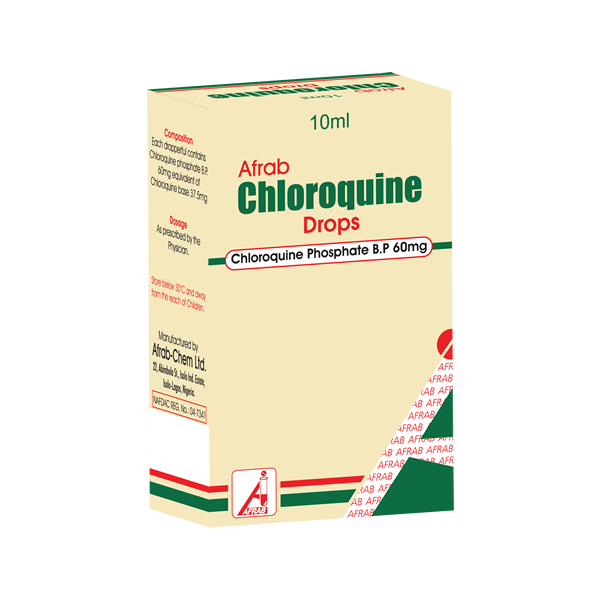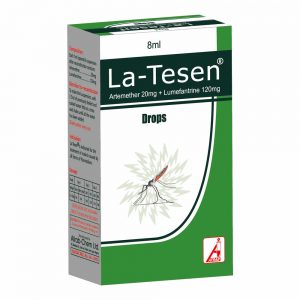- Have any questions?
- 0809 992 8864
- info@afrabchem.com
Products

Diastop
February 28, 2019La-Tesen Tablet
February 28, 2019Afrab Chloroquine
Oral drops (NRN: 04-7341): Each droperful (1 mL) contains: Chloroquine phosphate BP 60 mg equiv. to 37.5 mg Chloroquine base.
Pack size: Amber glass bottle of 10 mL.
Therapeutic Class
Antimalarial drugs
Dosage Form, Composition & NAFDAC Registration Number (NRN)
Oral drops (NRN: 04-7341): Each droperful (1 mL) contains: Chloroquine phosphate BP 60 mg equiv. to 37.5 mg Chloroquine base.
Pack size: Amber glass bottle of 10 mL.
Pharmacology
Antimalarial action may occur through inhibition of protein synthesis and alteration of DNA in susceptible parasites.
Indications
Chloroquine drop is indicated for the prevention and treatment of malaria.
Contra-indications
Care is necessary in administering chloroquine to patients with impaired liver or renal function or with porphyria and psoriasis. Reactions are more common in alcoholic.
The concurrent administration of chloroquine with drugs capable of inducing blood disorders such as gold salts should be undertaken with caution, if at all.
Patients receiving long courses of treatment with chloroquine should undergo regular examination for ocular disturbances.
Precautions/Warnings
Use cautiously in:
• Severe GI, neurologic, or blood disorders; hepatic impairment; G6PD deficiency; neurologic disease; eczema; alcoholism
• Pregnant patients
• Children
Interactions
Drug-drug: Aluminum and magnesium salts, kaolin: decreased GI absorption of chloroquine
Ampicillin: reduced ampicillin bioavailability
Cimetidine: decreased hepatic metabolism of chloroquine
Cyclosporine: sudden increase in cyclosporine blood level
Adverse Effects
Chloroquine is generally well tolerated when given in anti-malarial doses and adverse effects are rare. Side effects occurring with anti-material doses are usually reversible on withdrawal of the drug.
Over dosage is especially dangerous in children and after intravenous use. Headache, drowsiness, respiratory and cardiovascular depression, shock, visual disturbances and severe gastrointestinal irritation may be followed by convulsion, respiratory and cardiac arrest and death.
Prolonged administration of higher doses may lead to cornea and retinal changes. Changes may occur long after the drug has been withdrawn. Pigmented deposits and opacities in the cornea are often reversible if the drug is withdrawn early enough but retinal damage, with macular lesions, defects of colour vision, pigmentation optic nerve at reply and blindness has been reported and is usually irreversible.
Other uncommon side effects from prolonged use include loss of hair, bleaching of hair pigment, photosensitivity, tinnitus, reduced hearing, nerve deafness, neuromyopathy and myopathy.
Dosage & Administration
| Age | Dose | ||
| Day 1 | Day 2 | Day 3 | |
| Children under 1 year | 75 mg – 1 mL dropperful | 75 mg – 1 mL dropperful | 37.5 mg – ½ mL dropperful |
If symptoms persist two days after the course of treatment, consult your Physician.
Storage/Handling Recommendations
Keep in a cool dry place and away from children.




Reviews
There are no reviews yet.